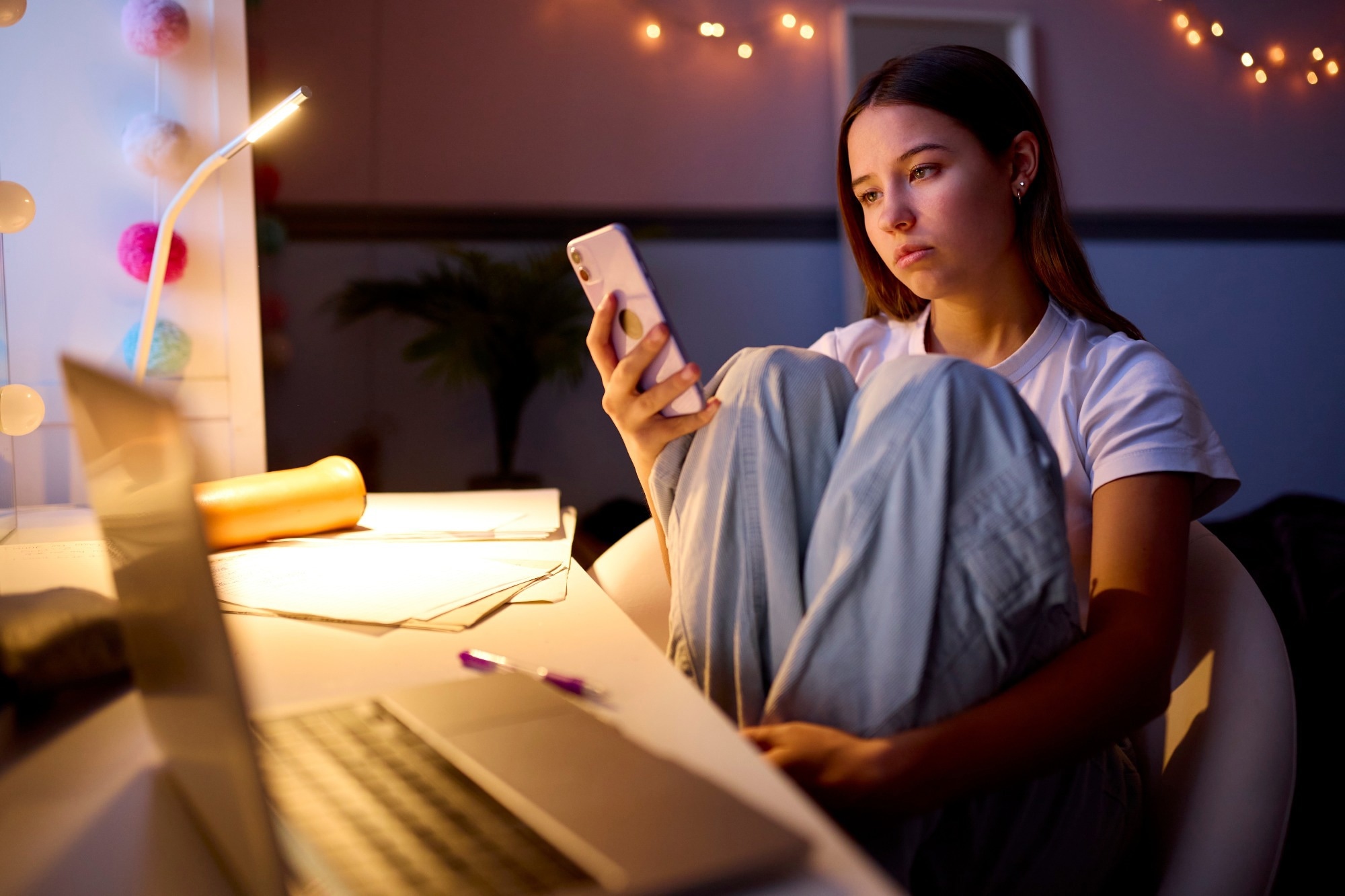In a recent article published in BMC Public Health, researchers presented nuanced accounts from 33 adults in Aotearoa (New Zealand) parenting adolescents.
The aim of the study was to understand parental perceptions on the management of adolescent screen use.
 Study: ‘I tried to take my phone off my daughter, and i got hit in the face’: a qualitative study of parents’ challenges with adolescents’ screen use and a toolbox of their tips. Image Credit: Monkey Business Images/Shutterstock.com
Study: ‘I tried to take my phone off my daughter, and i got hit in the face’: a qualitative study of parents’ challenges with adolescents’ screen use and a toolbox of their tips. Image Credit: Monkey Business Images/Shutterstock.com
Background
Young people are battling with an addictive digital existence. They use screens constantly throughout the day and night.
Research indicates that adolescents may use screen-based technologies such as smartphones, tablets, computers, and TVs for up to 11 hours each day. However, the majority of this research is quantitative and primarily targets young children, not adolescents.
The role of parents in influencing their adolescent children's screen use is significant. Parents not only supply these devices and establish rules for their use but also impact their children's screen habits through their own usage patterns.
Thus, there is an eternal parental tension concerning protecting their adolescents' safety while nurturing their autonomy, which raises ongoing and challenging situations.
Qualitative insights into parents’ subjective experiences and perceptions of managing their children's screen use habits are crucial.
It is also imperative to wisely negotiate digital life with adolescents for their long-term health and well-being.
About the study
In the present study, researchers used social media advertisements, snowball sampling, and word of mouth to enroll the study cohort, i.e., parents of children aged 13 to 16 years.
All 33 eligible participants provided written informed consent before participating in an interview or focus group.
A social science researcher with extensive experience conducted ten face-to-face interviews of ~50 minutes and six focus groups (with two to five participants) lasting ~90 minutes among study participants, which helped them understand their lived experiences about adolescent screen use, e.g., attempts to limit screen use or intervention for managing screen use.
Using a semi-structured discussion guide allowed for flexibility and exploring new issues not captured by previous exploratory studies. It also helped them cover several issues related to the research questions.
The data analysis process involved audio-recording and transcribing interviews and focus groups verbatim, which were then analyzed using NVivo 10 software.
Data interpretation, done using a general inductive approach, allowed the distilling of the key ideas and illustrative quotes to create a table of recommendations or summary themes from these in-depth conversations (raw data).
Results
The mean ages of participating parents (79% females) and their adolescent children were 48 and 14 years, respectively. Most of these children used a smartphone, followed by a laptop/PC (79% vs. 70%), with most children having access to more than one device.
This study identified four areas of specific concern among parents.
First, parents were concerned about their children's addict-like behavior, particularly in relation to mobile phones and gaming devices.
Parental attempts to monitor or reduce screen use even led to deceptive behavior, such as slithering out to turn on the Wi-Fi at night, creating fake social media accounts, switching screens to hide content, and obtaining passwords without parental knowledge.
Here, it is also important to note that these comments echo online survey research with parents/children during the COVID-19 pandemic, during which screen use among children intensified. Intriguingly, it was not the frequency of use but the addictive quality that hampered adolescents’ emotional, behavioral, and academic troubles.
The second concern was children accessing harmful or inane content. For boys, parents were worried about the viewing of pornography, and for girls, grooming and early sexualization were considered problematic.
The third concern of parents was that their adolescents no longer enjoyed activities that they previously enjoyed, and devices distracted and isolated them from the “real” world.
The virtual world provided opportunities for friendships, but lack of social interaction with online friends hindered their ability to develop interaction skills and real-life relationships.
Lastly, all parents were concerned about the adverse effects of excessive screen use on their children's physical, mental, and cognitive well-being.
The physical health effects of screen use included eye strain, hunching, back problems, sleep problems, and tiredness.
Parents also raised children facing mental health issues, such as anxiety, depression, and low self-esteem, and problems with cognitive processes, such as reduced attention span and inability to concentrate and focus, which even led to impaired academic performance in many cases.
Eventually, all participating parents shared a suite of practical ideas, which might serve as an ‘information toolbox’ of parenting strategies relating to screens for other parents and inform policy.
Conclusions
This study uniquely contributes to a global conversation, i.e., whether positive parenting, showing warmth, support, and positive reinforcement alone is enough to manage adolescent screen use.
Participants were aware of needing to ‘pick their battles’ carefully; indeed, managing screen addiction was a ‘battle’ worth fighting.
Moreover, they considered the quality relationship key besides their role-modeling influence on adolescents' screen use habits.
Accordingly, they wished that there is a ‘toolbox’ that would support building skills to achieve that. In addition, they wanted customized information and parenting strategies in this toolbox; thus, future research should underpin these points.
The narrative in the media might be playing a balance concerning technology use; however, the scientific evidence increasingly supports the idea that its harms outweigh the positives.
Thus, there is a critical need to change the narrative around adolescent screen use to improve their overall well-being and health, especially mental health.